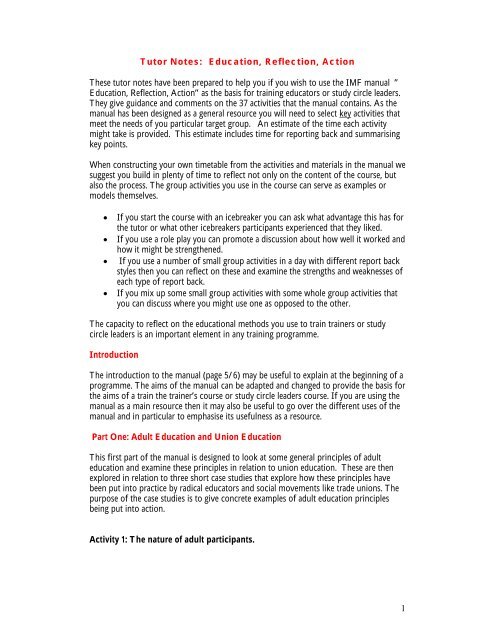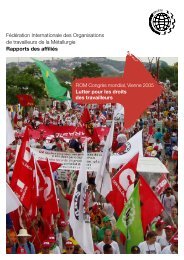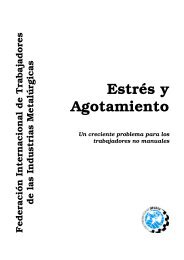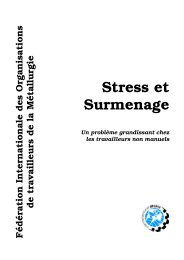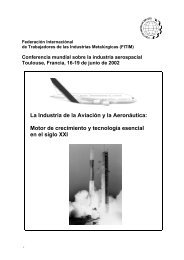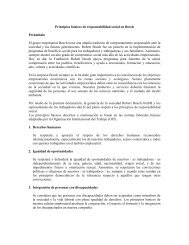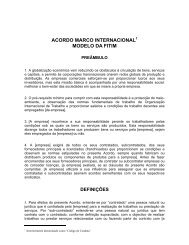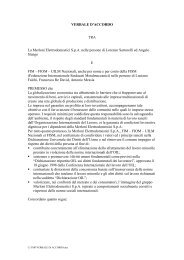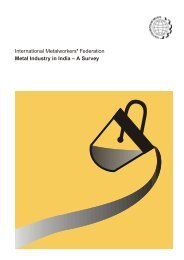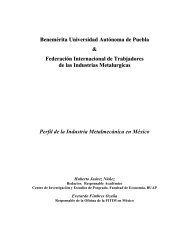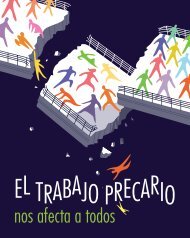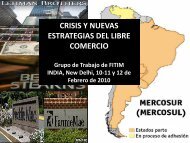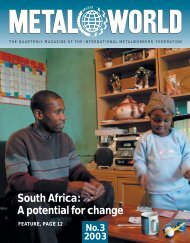Tutor notes: Education Reflection Action (pdf)
Tutor notes: Education Reflection Action (pdf)
Tutor notes: Education Reflection Action (pdf)
You also want an ePaper? Increase the reach of your titles
YUMPU automatically turns print PDFs into web optimized ePapers that Google loves.
<strong>Tutor</strong> Notes: <strong>Education</strong>, <strong>Reflection</strong>, <strong>Action</strong><br />
These tutor <strong>notes</strong> have been prepared to help you if you wish to use the IMF manual ”<br />
<strong>Education</strong>, <strong>Reflection</strong>, <strong>Action</strong>” as the basis for training educators or study circle leaders.<br />
They give guidance and comments on the 37 activities that the manual contains. As the<br />
manual has been designed as a general resource you will need to select key activities that<br />
meet the needs of you particular target group. An estimate of the time each activity<br />
might take is provided. This estimate includes time for reporting back and summarising<br />
key points.<br />
When constructing your own timetable from the activities and materials in the manual we<br />
suggest you build in plenty of time to reflect not only on the content of the course, but<br />
also the process. The group activities you use in the course can serve as examples or<br />
models themselves.<br />
• If you start the course with an icebreaker you can ask what advantage this has for<br />
the tutor or what other icebreakers participants experienced that they liked.<br />
• If you use a role play you can promote a discussion about how well it worked and<br />
how it might be strengthened.<br />
• If you use a number of small group activities in a day with different report back<br />
styles then you can reflect on these and examine the strengths and weaknesses of<br />
each type of report back.<br />
• If you mix up some small group activities with some whole group activities that<br />
you can discuss where you might use one as opposed to the other.<br />
The capacity to reflect on the educational methods you use to train trainers or study<br />
circle leaders is an important element in any training programme.<br />
Introduction<br />
The introduction to the manual (page 5/6) may be useful to explain at the beginning of a<br />
programme. The aims of the manual can be adapted and changed to provide the basis for<br />
the aims of a train the trainer’s course or study circle leaders course. If you are using the<br />
manual as a main resource then it may also be useful to go over the different uses of the<br />
manual and in particular to emphasise its usefulness as a resource.<br />
Part One: Adult <strong>Education</strong> and Union <strong>Education</strong><br />
This first part of the manual is designed to look at some general principles of adult<br />
education and examine these principles in relation to union education. These are then<br />
explored in relation to three short case studies that explore how these principles have<br />
been put into practice by radical educators and social movements like trade unions. The<br />
purpose of the case studies is to give concrete examples of adult education principles<br />
being put into action.<br />
Activity 1: The nature of adult participants.<br />
1
This is an important activity and the central message you are trying to get across by<br />
using it is that adults will bring both positive and negative things with them into the<br />
training room or study circle.<br />
It is as an example of a snowball activity where participants first work in pairs then<br />
fours. You may continue the snowball if you wish. By using a snowball at the beginning<br />
you are demonstrating the value of collective decision making right at the start. There is<br />
some text explaining snowball activities on page 54.<br />
Putting all the positive ideas on one side of a line drawn in the middle of a white board<br />
and the negative ones on the other side has two main uses. You can collect all the ideas<br />
together in one place. It is then straightforward to move to stage four of the activity<br />
which involves promoting a discussion about how the educator may attempt to turn<br />
some of the negative factors into positives.<br />
Estimated time to complete all stages: 90 minutes<br />
Activity 2: Your own experience<br />
This activity is designed to make participants think about their own experience of<br />
education and training in relation to the key principles of adult education identified in the<br />
text. Small groups can be given different principles to relate to their own experience. The<br />
activity asks for both positive and negative experiences. The report backs can be made<br />
by summarising the groups’ experiences on a flip chart or by asking them to talk about<br />
them.<br />
This activity can be useful if you are training educators or study circle leaders for the<br />
first time. If they have no experience as an educator they will have some experience as<br />
recipients of education and training and can reflect on this.<br />
Estimated time: 60 minutes<br />
Activity 3: Union values and adult education<br />
This activity seeks to make the link between union values and adult education.<br />
Participants are asked to agree what the key values of their union are and then relate<br />
these to both the adult education principles and the case studies. The purpose of this<br />
activity is to indicate that union values are central to union education and that there are<br />
links between adult education principles and these union values. It also promotes the<br />
idea through the case studies that action and change are central to union education and<br />
that union education is not just technical. This introduces the concept of active learning,<br />
which is summarised on pages 15/16.<br />
Estimated Time: 45/60 minutes<br />
Summary<br />
When training education officers or study circle leaders it is useful to start with some of<br />
the wider issues of adult education and union education. Activities one and three have<br />
both been piloted in Australia with shop stewards (union reps), who were being trained<br />
to become member educators or study circle leaders. They found tackling this wider<br />
2
context challenging at first, but worth while on reflection. Looking at the link between<br />
union values and adult education principles makes a valuable connection. Activity two is<br />
perhaps best seen as an alternative to activity one and it is unlikely that you will need to<br />
use both of them in the same course.<br />
Part Two: Union <strong>Education</strong> Aims and Programmes.<br />
Part two of the manual looks more closely at union education, its aims and programmes.<br />
The early part of the text suggests some of the main aims of union education. This is<br />
followed by four case studies of union education programmes in four different IMF<br />
affiliated unions.<br />
Activity 4: Your own union education programme<br />
This activity helps participants look at their own union education programmes and<br />
compares them to the general aims in the text. Participants can add to the aims in the<br />
manual or suggest ways in which their own programme can adopt new aims. The idea<br />
here is to suggest that existing programmes can always be improved. You can adapt this<br />
activity to look at a national programme or a local, regional programme.<br />
Estimated time: 45/60 minutes<br />
Activity 5: Arguing the case for education.<br />
This activity is a simple role play where participants have to argue against cuts in the<br />
education programme proposed by a union executive. Those arguing against the cuts<br />
have to demonstrate the value of union education to the union. This activity can be set<br />
up between two groups and the rest of the participants acting as observers. If you want<br />
to maximise participation you may chose to run a number of different role plays in turn.<br />
With a role play like this it will be important to summarise the key arguments in favour<br />
of union education.<br />
Estimated time: 45 minutes<br />
Activity 6A: Learning from other unions<br />
The four case studies of IMF affiliated unions have been selected to learn about how<br />
other unions organise their education. As the case studies will take a while to absorb this<br />
activity is organised as a jigsaw activity.(see page 55) Participants work in four different<br />
groups and each group looks at one of the case studies and discusses it. They then have<br />
to go to another group and tell the group about the case study. They will also learn about<br />
the other case studies from other group members. Jigsaw activities are a good way of<br />
reinforcing recently acquired knowledge. They also avoid repetitive and lengthy report<br />
backs. They are described on page 55.<br />
Estimated time: 60 minutes<br />
Activity 6B: Learning from other unions<br />
3
This is a more traditional approach to the case studies. Participants are asked to look at<br />
all four case studies and identify any common themes or interesting ideas that they might<br />
adapt for their own programmes. If you decide to use this activity and not six a, you will<br />
need to be aware that participants will spend quite a long time reading through the four<br />
case studies.<br />
Estimated time: 75 minutes.<br />
Activity 7: The scope of union education programmes<br />
The last activity in this section poses some basic questions about dealing with wider<br />
political and social issues. Should this be done and if so how? It also asks whether skills<br />
can be considered political. The purpose of the activity is to develop debate around one<br />
of basic issues of union education programmes. Should they deal with wider social and<br />
political issues or be focused on a narrower skills based agenda? It also asks whether<br />
these two things are contradictory.<br />
Although described as a small group activity these questions could also be raised as part<br />
of a whole group discussion.<br />
Estimated time: 45 minutes<br />
Summary<br />
This part of the manual may be most useful if you are working with participants from a<br />
number of different unions. It is also a useful resource section if a union is wishing to<br />
review its education programme. Even if you are working with educators from the same<br />
union it may be helpful to examine the general aims of education. There is also a natural<br />
link between this second part of the manual and the first.<br />
Part Three: The Union <strong>Education</strong> Process<br />
Part three of the manual is concerned with the education process. The education process<br />
is broken down for analysis into what is described as the three main elements;<br />
participants, the educator and the educational material.<br />
Activity 8: A profile of your course participants<br />
This is a key activity and participants are asked to build a profile of the main<br />
characteristics of the target group they are teaching. It is designed to make educators<br />
think about the nature of their target group and their strengths and limitations. In this<br />
way they can design or put together appropriate educational material.<br />
4
In order to produce some variety in reporting back it is suggested you ask small groups<br />
to select different target groups, if this is possible. In summarising this activity you<br />
should stress that a process like this is always useful when preparing materials for a new<br />
group of unionists.<br />
Estimated time: 45 minutes<br />
Activity 9: Responding to women members educational needs.<br />
Building a profile of who you are working with is a simple form of learning needs<br />
assessment. This activity takes this a stage further by looking at a survey of women<br />
members conducted by the United Steelworkers of America. Small groups are then asked<br />
to come up with an educational strategy for meeting these needs. This is the kind of<br />
activity you would use with education officers, rather than study circle leaders.<br />
You should note that there is no separate section on women in the manual. A<br />
mainstreaming approach has been taken instead.<br />
Estimated time: 45 minutes<br />
Activity 10: Identifying learning needs.<br />
This is more general activity on learning needs, where participants are asked to select a<br />
group they wish to work with and discuss what they think the main learning needs will<br />
be. The activity demonstrates the importance of collective brainstorming when starting<br />
to put together a course or study circle. You will need to divide your participants into<br />
small groups and it is again useful if some of the target groups are different.<br />
Estimated time: 45/60 minutes<br />
Activity 11: Improving your education resources<br />
An important skill for any educator is to find appropriate resources. There is some text<br />
on this to help new educators think about where best to look. This activity makes<br />
participants think about what key resources they use currently and how they might<br />
develop these resources further.<br />
Estimated time: 45 minutes.<br />
Summary<br />
The activities in this part of the manual are designed to make future educators/ study<br />
circle leaders think about the education process. In particular to start by looking at what<br />
the educational needs are of the target group. In summarising these activities it will also<br />
be important to stress that educational needs are also defined by union policy and<br />
increasingly the threats facing unions in many countries. Reference back to the case<br />
studies in part two and forwards to the case studies in part nine would be useful here.<br />
You may notice that there is no activity in this section on the role of the educator/ study<br />
circle leader, although there is an important checklist. This is because the role of the<br />
educator is discussed extensively in the next three parts of the manual.<br />
5
This would be a good time to review the different kinds of activities that have been used<br />
so far as you are about to go on and ask participants to write and run their own activities.<br />
Part Four: Group Work<br />
This is the part of the manual concerned with teaching participants to construct and run<br />
small group activities effectively. Facilitating small group activities is divided into four<br />
distinct stages and tips given on each stage.<br />
Activity 12: Model session<br />
The best way to demonstrate what is involved is for the tutor to run a model session.<br />
Observers are selected to look at what is done and an observation form is used (page 51)<br />
by selected participants. In selecting a model activity you need to choose an activity that<br />
is easy to follow and has a specific outcome. When the model activity is finished the<br />
observer will give a report of how the activity was conducted.<br />
Estimated time: will depend on the activity selected. It is suggested that the activity and<br />
observer report should not take longer than an hour.<br />
Activity 13: Practising using activities / Activity 14: writing your own activities.<br />
Depending upon you target group you can now select either activity 13 or 14. Activity 13<br />
asks participants to work in pairs or small groups to run an education session using<br />
existing material, while Activity 14 asks participants to prepare their own activity and<br />
then run it. The first may be appropriate for new study circle leaders and the second for<br />
educators.<br />
Whichever you choose, the teaching practice sessions are much the same. Each group of<br />
2/3 participants run an education session using the other participants in the workshop.<br />
One participant is usually selected to observe what the group does, using the observation<br />
form. At the end of the session the observer gives a report. This report can then<br />
reinforced by the tutor. To avoid too much negative criticism an observer should be<br />
asked to mention at least one positive observation for every negative one. The tutor<br />
should make a positive comment at the end of the session.<br />
You will need to timetable in a session for the different groups to prepare their sessions.<br />
You will need to be available for advice and support while they are doing this. If<br />
participants are preparing their own activities, rather than using existing material they will<br />
need more time. It may be useful to have a sample pack of activities available for them<br />
to look at<br />
As all participants will need to run a session, these teaching practice sessions will take<br />
time. They represent the core of a training trainers course or workshop. It is likely that<br />
the model session, practice sessions and reinforcement of the key skills involved will take<br />
up to two days. You will need to think about this when deciding how many people to<br />
train in any workshop or course.<br />
6
Estimated time: 45 minutes preparation for existing material, 90 minutes to prepare own<br />
activity<br />
Allow one hour for each group of 2/3 participants to run their session and receive<br />
feedback.<br />
Activity 15: Strengths and weaknesses of group work<br />
This activity identifies some of the strengths and weaknesses of group work. Having<br />
identified some of the weaknesses participants are given some of these weaknesses in<br />
groups to suggest how they may be minimised. The main point of this activity is to<br />
indicate that some of the weaknesses are concerned with poor practice and planning and<br />
can be minimised or removed by good practice.<br />
Estimated time: 25 minutes task one, 45 minutes task two<br />
Part Five: Active Learning and the Whole Group<br />
This part of the manual deals with developing activities that take place with the whole<br />
group or workshop. They include managing discussion, whole group activities like<br />
sculptures and mapping, field visits and using films and videos. The central idea here is<br />
that an active approach is not limited to small group work and that small group work and<br />
whole group activities can be part of an integrated approach.<br />
Activity 16: Managing discussion / Activity 17: Developing a general session<br />
These two activities are concerned with planning and managing general discussion. This<br />
is an essential skill for prospective educators to develop and they are key activities. We<br />
suggest you include one or both of them in your timetable.<br />
In Activity 16 participants are asked to think about how they would tackle a number of<br />
common problems. To avoid repetition in the report back stage it might be useful to give<br />
groups different problems to work with. If the problems are not relevant to your own<br />
movement, then we suggest you construct some of your own to add to the list that are<br />
more appropriate.<br />
Activity 17 is designed to emphasise the need to plan a general session and develop key<br />
questions to construct the session. Participants work in pairs and in summarising the<br />
session a few pairs could be asked to indicate what questions they have developed to<br />
construct the session and why.<br />
Estimated time, Activity 16: 30 minutes<br />
Activity 17: 30 minutes<br />
Activity 18: Preparing a whole group activity<br />
This activity follows some text which describes different kinds of whole group activity<br />
like mapping, sculptures etc. Groups are asked to come up with their own ideas for a<br />
whole group activity. If you have time you may wish to demonstrate one or two of their<br />
7
ideas. Most whole group activities are relatively quick and will only take a few minutes to<br />
organise.<br />
Estimated time: 30 minutes, add another 30 minutes if some groups demonstrate their<br />
whole group activities.<br />
Activity 19: Using speakers<br />
This activity deals with the use of outside speakers. It is designed to make participants<br />
think about why they are used, how to make best use of them and how to prepare for an<br />
outside speaker. The main message here is to integrate their presentation into the aims or<br />
learning outcomes of the course or study circle.<br />
Estimated time: 45 minutes<br />
Activity 20: Using films and video<br />
The use of films videos, cd's and dvd's is guided by a similar message. A different<br />
approach is taken here and participants are paired up to argue the case for and against<br />
the use of visual media. In summarising this paired role play you can reinforce the<br />
message of planning and appropriate use.<br />
Estimated time: 45 minutes<br />
Summary<br />
This part of the manual examines different ways of working with course participants<br />
without dividing them into small groups. It seeks to demonstrate that whole group<br />
activity can be varied, active and structured. How many of the activities you choose to<br />
include may well depend upon the time you have available and your own priorities. It is<br />
important for new educators to understand that they can balance small group working,<br />
role plays etc with whole group sessions as they gain experience. The skill of managing<br />
general discussion is something they will all need to be confident about.<br />
Part Six: Developing Your <strong>Education</strong>al Materials<br />
This part of the manual is mainly concerned with designing educational materials. It deals<br />
with the essential elements involved in developing a course or programme. This includes<br />
focusing on educational needs, developing course aims or learning outcomes and<br />
developing and structuring a course or workshop. It covers some of the basic principles<br />
of curriculum development using active learning methods.<br />
Activity 21: Critiquing your education materials.<br />
This activity is designed to develop a critical approach to educational materials. Ideally<br />
participants can bring in some of the material they currently use to critique. Alternatively<br />
8
the tutor can provide examples for participants to look at. They are asked to examine the<br />
material against some of the adult education principles they will now be familiar with. It<br />
is helpful if the groups look at different material or examples.<br />
In summarising this activity it is important to be positive and stress that all education<br />
materials should be assessed from time to time and improved.<br />
Estimated time: 45 minutes<br />
Activity 22: Approaches to health and safety<br />
This activity is designed to reinforce the idea of a union approach to issues. Participants<br />
work in pairs and contrast a management approach to health and safety training and a<br />
union approach. It serves to remind union educators, who are preparing their own<br />
materials, that union education is not just technical. It should be built round a union<br />
perspective. The report back can be verbal with two or three pairs indicating what ideas<br />
they have come up with.<br />
Both this and the previous activity are designed to make participants aware of the<br />
political and social values that should underpin union education.<br />
Estimated time; 45 minutes<br />
Activity 23: Meeting changing needs<br />
This activity addresses the question of changing educational needs. It asks participants to<br />
think about the factors that might make educational material out of date and in need of<br />
change. Groups are then asked to come up with ideas to identify changing needs. Here<br />
the report back could be organised by the tutor writing up the ideas on whiteboard. Each<br />
group could be asked for one idea at a time to compile a list.<br />
Estimated time: 45 minutes<br />
Activity 24: Writing workshop aims<br />
Writing workshop aims is often a starting point for material development, once learning<br />
needs have been identified. This activity asks groups to look at two examples of<br />
workshop aims in the text and improve them. In a second task the groups are asked to<br />
select a course /workshop/ or study circle on a particular topic/ issues and write some<br />
aims for it. For this second task it would be useful if each group selected a different<br />
subject area to work with. This will make for a wider exchange of experience at the<br />
report back stage. Each group should be asked to put their aims on a flip chart to present<br />
their ideas.<br />
Estimated time: task one 20 minutes, task two 30 minutes<br />
Activity 25: Starting a workshop<br />
There are now many different “icebreakers” used in union training and training generally.<br />
This is a paired activity where participants think about their own experiences of<br />
icebreakers and begin to identify what works well and what doesn’t. As with other paired<br />
9
activities you can ask for a handful of responses from some of the pairs to draw out the<br />
key points.<br />
Estimated time: 20 minutes<br />
Activity 26: Linking activities together<br />
One of the difficulties with curriculum development is to decide how to develop a<br />
subject or issues. In the text we suggest that an issue or topic can be broken down into<br />
an introductory stage, an analytic stage and an action or strategy stage.<br />
This activity is designed to help participants use this framework to explore an issue /<br />
topic in depth. Groups are asked to select a topic / issues and plan a series of activities<br />
using this approach. This is a key activity for anyone involved in putting a workshop or<br />
course together. The text has examples for them to read through before they attempt<br />
their own plan.<br />
Once again it would be useful if most of the groups are working on different topics or<br />
issues.<br />
Estimated time: 60 minutes<br />
Activity 27: Designing a workshop programme<br />
Having looked at handling an issue in the previous activity this activity takes things one<br />
stage further and asks groups to draw up a plan for a whole course, workshop or study<br />
circle. Participants get an opportunity to practice timetabling and identifying suitable<br />
resources.<br />
A gallery report back is suggested where the groups put their plans on flip charts around<br />
the room. The participants then walk around the room viewing the various plans and<br />
asking questions of the group members, who constructed them. Alternatively the<br />
different plans could be photocopied and distributed for discussion<br />
Estimated time: 60/90 minutes<br />
Summary<br />
The activities in part six will mainly be of use if you are working with experienced<br />
educators or study circle leaders. They are designed to help participants develop some<br />
curriculum development skills. It is likely that you will also have to provide some course<br />
writing skills training if they are going to attempt major curriculum development. This is<br />
outside the scope of this manual.<br />
Part Seven: Planning and Organising Your <strong>Education</strong>al Activities<br />
There is a close relationship between this part of the manual and part six. Part six is more<br />
to do with the creative process in developing materials. This part is more about<br />
organising your educational sessions and activities. Most educators involved in union<br />
education will recognise that there is often a tension between these two aspects of<br />
running courses and workshops. Both well developed materials and well organised<br />
10
education course and workshops are necessary elements of a successful union education<br />
programme.<br />
Activity 28: Planning an education session<br />
This activity aims to give educators and study circle leaders the skills to plan an education<br />
session effectively. It deals with issues like having clear aims and timing a session.<br />
Participants work in groups or in pairs to draw up a session plan. You will need to<br />
provide blank session planning forms for this activity. You may have your own or you<br />
can construct a session planning form along the lines of those used for the two examples<br />
on pages 96 of the manual.<br />
Estimated time: 30 minutes<br />
Activity 29: Improving your planning and organisation<br />
This activity is built around an extensive checklist for organising educational course,<br />
workshops or study circles. Groups work on different headings in the checklist (e.g.<br />
recruitment, venue etc.) They are asked to draw up a strategy to improve this aspect of<br />
their own planning and organisation. They then give a report to another group who have<br />
looked at a different set of problems and listen to their ideas. The two reports are<br />
improved and then the main ideas placed on flip charts for other groups to examine.<br />
Estimated time: 45 minutes<br />
Summary<br />
Good planning is an essential ingredient of union education. The financial resources for<br />
union education programmes are usually scarce. The checklist which is at the centre of<br />
this section was constructed by experienced educators. It is important to stress the<br />
practical use of this kind of checklist in ensuring educators are well organised and best<br />
use is made of these scarce resources.<br />
Part Eight: Evaluation<br />
This part of the manual deals with evaluation. It is concerned with issues such as the<br />
usefulness of evaluation, the different types of evaluation and the relationship between<br />
evaluation and reflection.<br />
Activity 30: Reviewing your experience of evaluation<br />
This activity is designed to assist participants reflect on their experiences of evaluation. It<br />
will help the tutor find out what evaluation tools the participants are familiar with. The<br />
participants will be able to compare their own experiences.<br />
Estimated time: 30 minutes<br />
11
Activity 31: Critiquing evaluation tools.<br />
In stage one of the activity participants are asked to critique one of two example<br />
evaluation forms. A group who has worked on one form will work together with a<br />
group who looked at the other to compare their experiences. One of the forms is mainly<br />
quantitative and the other qualitative. The idea is to promote a discussion between the<br />
two and assess when their use is relevant.<br />
In summarising this activity you may wish to stress the importance of looking at<br />
evaluation tools and assessing their usefulness and the need to improve them.<br />
Estimated time: 45 minutes<br />
Activity 32: Who to involve in your evaluation programme.<br />
The main purpose of this activity is to get participants to think about the scope and<br />
information to collect in an evaluation exercise. Groups are given one or two specific<br />
scenarios and then asked to identify who to involve and what to ask them. The scenarios<br />
can easily be replaced by more specific scenarios if these are more relevant to the group<br />
being trained. It may be useful to use a gallery report back mechanism for this exercise.<br />
Estimated time: task one 30 minutes, task two 30 minutes<br />
Activity 33: Critiquing your evaluation tools.<br />
This is a more complex activity than activity 31, which can be used when you are<br />
working with educators who have an evaluation scheme already in place. The activity<br />
encourages participants to become familiar with the Kirkpatrick model of evaluation. It<br />
also highlights how to use the results of evaluation exercises.<br />
Estimated time: 90 minutes.<br />
Summary<br />
Effective evaluation of union education programmes is both valuable and useful. This<br />
part of the manual encourages educators too go beyond the traditional end of course<br />
evaluation form and find out what a range of stakeholders feel about a particular<br />
programme. It is useful for educators to understand some of the basic concepts involved.<br />
The Kirkpatrick model is useful for those involved in evaluating complete programmes.<br />
If one of the goals of union education programmes is to bring about change then<br />
measuring whether this change has happened becomes of critical interest.<br />
Part Nine: Union education, change and the global economy.<br />
The final part of the manual deals with some of the current wider political, social and<br />
economic issues that make up the environment in which union education takes place.<br />
The first case study is based on the experience of the Australian trade union movement<br />
in fighting decline. The second case study is from the metalworkers in Brazil dealing with<br />
unemployment. This is followed by examples of a Canadian union and UK unions<br />
12
developing education materials on globalisation. The section ends with the IMF policy<br />
on globalisation.<br />
Activity 34: Organising in everything we do<br />
This activity explores the link between union education and organising, based here on the<br />
Australian experience. Participants are asked to look at their own courses and develop<br />
greater links between education and organising. If participants don’t have existing course<br />
material with them then they can be given a number of different scenarios in groups.<br />
Having developed a report on what they are going to do they work together with another<br />
group to compare experiences and ideas.<br />
Estimated time: 60 minutes<br />
Activity 35: Working with the unemployed<br />
This activity is built round the Brazilian case study, where the Brazilian metalworkers<br />
have developed extensive programmes with the unemployed. As with the previous<br />
activity participants come up with some ideas in small groups and then compare their<br />
reports with another group.<br />
Estimated time: 45 minutes<br />
Activity 36: Dealing with globalisation / Activity 37: education and globalisation.<br />
The final two activities in the manual deal with globalisation and union education.<br />
Activity 36 poses three basic questions about globalisation. It is suggested that<br />
participants work in pairs to answer them.<br />
Activity 37 asks participants to work in groups on one of two tasks. The first is to<br />
examine opportunities to introduce global issues into existing programmes. The second<br />
is to outline a specific course for a specific target group on global issues. The groups<br />
place their ideas on flip charts and report to the whole course workshop. The examples<br />
from IMF affiliates in Canada and the UK will be helpful resources, as will the IMF<br />
policy on globalisation. An alternative would be to give groups both of the tasks. If you<br />
do this you will probably need to organise a report back after each task is completed.<br />
Estimate time: Activity 36, 45 minutes<br />
Activity 37, 60 minutes.<br />
Summary<br />
This final part of the manual has many links to part one. They are both concerned with<br />
the political and social context of union education. It will be useful to make links<br />
between the case studies in part one.<br />
Unions have always been concerned with issues such as the economy and the<br />
distribution of wealth. As the global economy has developed it is inevitable that unions<br />
will need to deal with global issues in their education programmes. Questions such as<br />
who is currently benefiting from globalisation and the behaviour of global institutions<br />
become paramount if an alternative to corporate driven globalisation is to be realised.<br />
13


